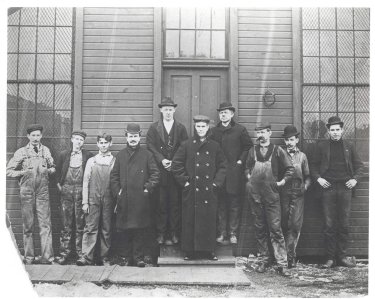
Owens the Innovator

Michael J. Owens and Edward Drummond Libbey were men of contrasts. Libbey came from a New England family, was highly educated at a boarding school in Maine, and became involved in the glass industry at 24 when his father brought him in to help manage his factory. Owens, on the other hand, was from a poor Irish family and began working at a very young age in the coal mines of West Virginia. After his family moved to Wheeling, he got a job in a glass factory at 10 years of age where he performed the hot, difficult, and dangerous child labor work required to make glass containers by hand. He had little formal education, but much practical experience by the time he was hired by Libbey. As supervisor of the Libbey plant, he was known for his demanding management style and rough language.
In 1890, a strike at the Corning Glass Works in upstate New York led to a critical shortage of light bulbs needed by the Edison General Electric Company for its booming electric business. Libbey agreed to take over production during the strike, and leased an idle glass plant in Findlay to produce the bulbs. Owens was put in charge as plant superintendent. For 17 months, the company produced bulbs at significant profit, wiping out the debt generated at the struggling Libbey Glass plant in Toledo and allowing the firm to survive. Owens and general manager Sol Richardson were credited with saving Libbey's company. Another success for Owens was the 1893 Columbian Exposition exhibit where he oversaw operations of the Libbey glass factory.
When he returned to Toledo from Chicago, Owens began to experiment on a machine that would automate some of the processes used to make light bulbs. He established an experimental operation within Libbey Glass to develop a semi-automatic machine that would blow bulbs into molds. The machine had five rotating arms. Each arm had a device similar to a blow pipe with a mold at the bottom. A glob of molten glass would be picked up onto the pipe, the mold would surround it, and compressed air would blow the glass into the mold. The machine could produce 2000 bulbs in five hours. While it actually took more workers to produce bulbs using this method, they no longer had to be skilled workers, thus reducing costs.
Libbey was impressed with the work Owens had done on the machine, and decided to spin off a new company built around Owens's innovations. Both he and Owens ceased to be involved in the Libbey Glass Company operations, and they concentrated their efforts on the new firm. The Toledo Glass Company was incorporated in December 1895, with $150,000 in capital. Shareholders included Libbey and Owens. The purpose of the company was to develop and license new innovations in glass production. They also sought to buy patents for existing glass production processes and products. The factory was located near the corner of Delaware and Detroit in the Auburndale area.
Owens's bulb making machine was converted to make glass tumblers and glass lamp chimneys. Working with William E. Bock, a skilled engineer, in 1898 Owens turned his attention to producing a fully automatic machine to produce glass bottles. During the next five years, the bottle machine would cost over $500,000 to develop before it was successful.
Anxious to begin turning a profit, in 1903, a brand new company the Owens Bottle Machine Company was created to license the new invention. A European firm was created in 1905 to license it abroad. The company continued to buy other glass-related companies, including the Kent Machine Company in Grand Rapids, Michigan; a sand quarry near Sylvania, Ohio; and a company that produced cardboard boxes (for shipping bottles). Over 15 companies were purchased between 1909 and 1920. With these acquisitions, the company became not only a producer and licenser of bottle machines, but also a producer of bottles. In 1919, the company changed its name from the Owens Bottle Machine Company to the Owens Bottle Company to reflect the change in emphasis. New versions of the bottle machine were also perfected, with over 300 versions of the machine produced between 1908 and 1927.
As evidence of the importance of Owens's machine to the industry, within 20 years nearly all bottles manufactured in the United States were produced automatically. Standardization of bottle sizes and quality led to high-speed filling capabilities by those who used the bottles. As a result, the bottle machine had a huge impact on food, soft drink, pharmaceutical product, and alcoholic beverage producers.
At the Ward M. Canaday Center for Special Collections
Photographs, Michael J. Owens, ca. 1898 to 1923. L-O-F, MSS-066; O-I, MSS-200.
While Owens was more responsible for the success of the glass industry in Toledo than anyone, even E. D. Libbey, he is in many ways unknown to history. Few photographs of him exist, and there is little that reveals his personal life. Only one image is known to exist with Owens and his famous machine, and that image is taken from a short film made in 1910. While he had little formal education, he was an avid reader and trained himself in public speaking. These photographs show Owens through the years he lived in Toledo, including a rare photo of Owens standing with some of the workers at one of the glass plants.
Minute book, the Toledo Glass Company, 1895-1908. L-O-F, MSS-066.
This minute book documents the history of the company Libbey and Owens founded to exploit the technological innovations of Owens, particularly automated processes for producing bottles. The minutes from October 16, 1903, document the transfer of all of the patents and licenses involving the bottle machine to a brand new company, the Owens Bottle Machine Company.
Correspondence concerning Owens patents, 1898, 1906. L-O-F, MSS-066.
These extensive reports from lawyers working for E. D. Libbey and the Owens Bottle Machine Company review the patent claims concerning the Owens's innovations to automate glass blowing.
"Comparative Estimate of Production Costs," ca. 1905. O-I, MSS-200.
To promote its new bottle machine, the Owens Bottle Machine Co. produced this small sales pamphlet that compares the cost of hand production of bottles to the cost of using the bottle machine.
Photographs, interior and exterior of the Owens Bottle Machine Co., ca. 1904. O-I, MSS-200.
Owens's workers constructed bottle machines at this factory on Wall Street in Toledo. The machines were then licensed to various bottle manufacturers.
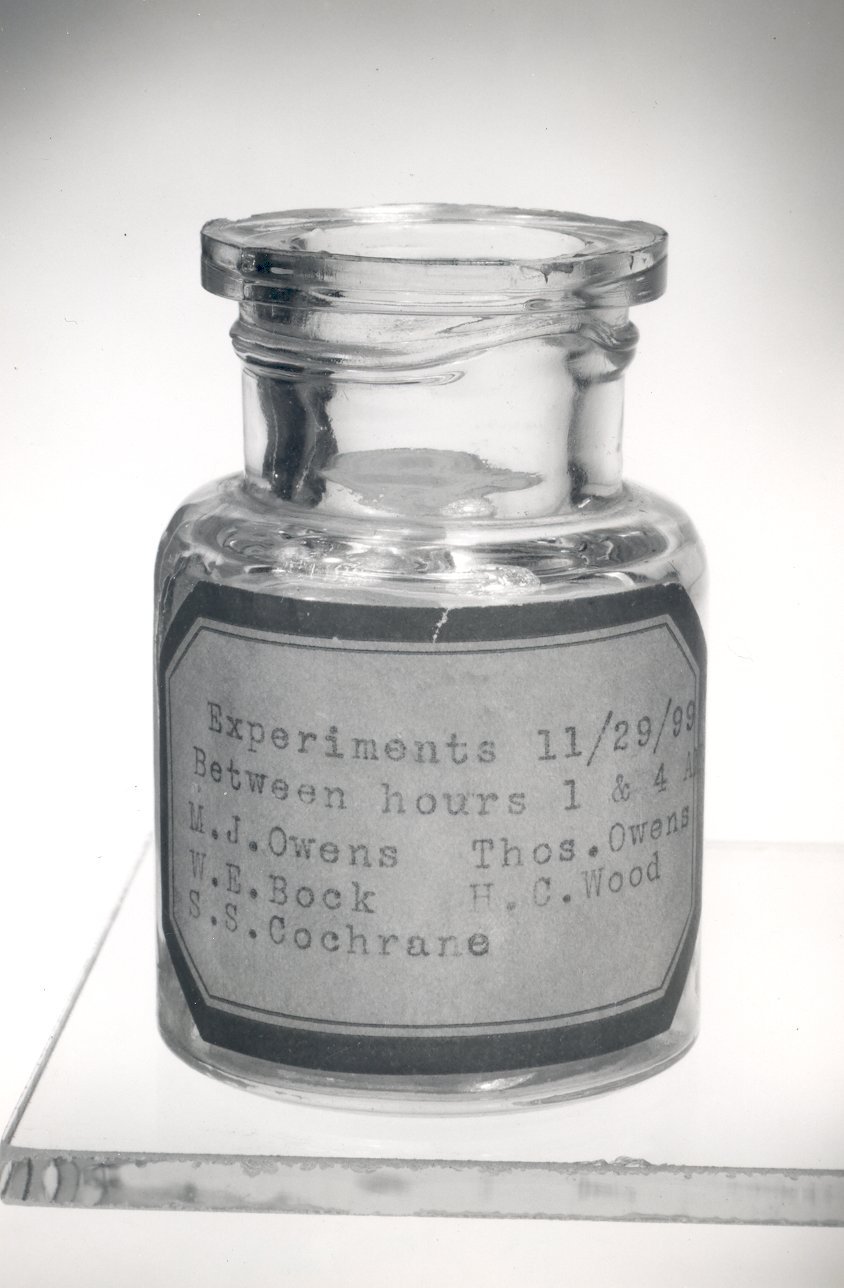 Correspondence with the
Greenfield Fruit and Jar Company, 1912. O-I, MSS-200.
Correspondence with the
Greenfield Fruit and Jar Company, 1912. O-I, MSS-200.
This company, which was purchased by the Ball Company, ordered nine Owens machines to make fruit jars in 1912. Because of some difficulties in making the quart-sized jar, F. C. Ball asked to come to Toledo to see the machines in production. Purchasing the machines allowed the Ball Company to automate its processes and become highly successful as a producer of canning jars.
Photograph, Board of Directors of the Owens Bottle Machine Company, ca. 1905. L-O-F, MSS-066.
The Ohio Bottle Company of Newark, Ohio, was the first licensee of the bottle machine. The directors traveled to the company to see the machines in production and inspect the factory. Included in the photograph are Libbey, far right; and Owens, in cap, fifth from the left.
Articles of Incorporation, the Owens Bottle Machine Company, 1907. O-I, MSS-200.
These incorporation papers were signed by all the principals in the company, including Libbey, Owens, and Walbridge, who became president that year.
Annual reports, the Owens Bottle Machine Co., 1909-1910. O-I, MSS-200.
Five years after the bottle machine
was first successfully produced, the company had earnings of over $1 million.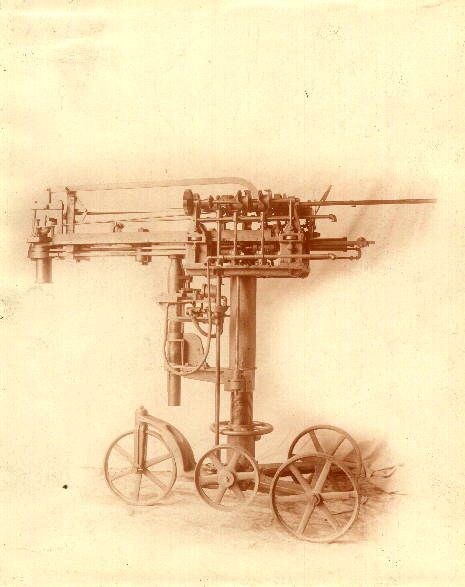
Photographs, various models of the Owens Bottle Machine, ca. 1905-1920. O-I, MSS-200.
The Owens Bottle Machine was an engineering marvel, and these photographs of the various models reveal its amazing complexity.
Catalog, Owens Flow Type Bottle Machines, 1925. O-I, MSS-200.
This catalog shows various models of the bottle machine available for purchase.
Catalog, Owens Bottles, ca. 1920s. O-I, MSS-200.
A catalog promoting the products made by the company after it changed from just producing bottle machines to also producing bottles.
Drafting document, "Supporting and Centering a Glass Blank," 1914. O-I, MSS-200.
Because Owens himself was not an engineer, he would explain his concepts in detail to his draftsmen, who would then try to develop the product. This is one such document, outlining a new idea of Owens to improve the bottle machine.
 Mechanical drawings by Michael Owens, 1915-1922. O-I, MSS-200.
Mechanical drawings by Michael Owens, 1915-1922. O-I, MSS-200.
These concept drawings of the AQ version of the bottle machine are presumably in Owens's hand. The drawings show his constant tinkering with the mechanics of the bottle machine, and his talent at improving the mechanization process.
Survey drawing, the Owens Bottle Company, 1925 (revised 1929). O-I, MSS-200.
This large color rendering shows the layout of the Owens Bottle Company, located on Wall Street in Toledo near Detroit and Delaware.
Correspondence of Michael Owens, ca. 1907-1914, n.d. O-I, MSS-200.
Few personal papers of Owens are known to exist. This correspondence, sent to Richard LaFrance during a trip Owens made to Florida in 1914, deals with aspects of the business, and shows that even while on vacation for five weeks, Owens remained a hands-on director of the company. An undated letter to William Walbridge (ca. 1907) congratulates him on being named president of the Owens Bottle Company. Owens offers Walbridge some advice on succeeding in his new position.
Photographs, Owens family, ca. 1914. L-O-F, MSS-066; O-I, MSS-200
These photographs, believed to date from Owens's trip to Florida in 1914, show him and his wife during their vacation.
Letter, Owens to E. D. Libbey, 1921. O-I, MSS-200.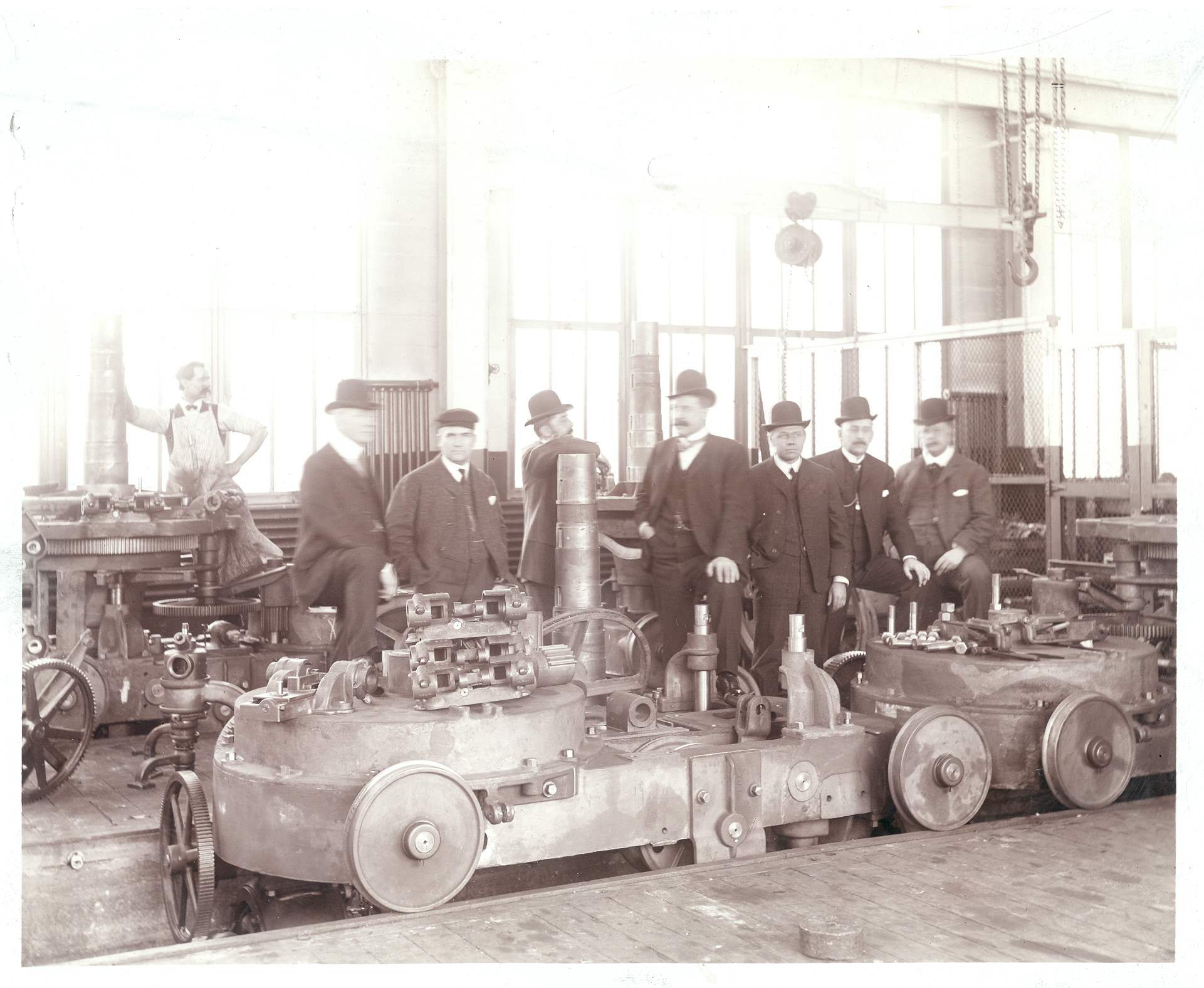
The personal relationship of the two men of Toledo glass is unknown, but this letter provides one clue. In it, Owens states how he has enjoyed his work with Libbey for 33 years, and his inventions paid considerable royalties to the Owens Bottle Company. However, Owens states that he himself has not been compensated sufficiently for his many innovations. He requests to be paid a royalty for each bottle and box of plate glass produced. He also indicates his desire to retire in five years, and live off the royalty payments. There is no letter indicating Libbey's response to Owens's request. Owens never got the chance to retire, as he died two years after this letter was written.
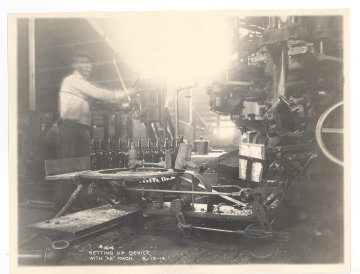 Tribute to Michael J. Owens, 1923. O-I, MSS-200.
Tribute to Michael J. Owens, 1923. O-I, MSS-200.
Owen's life of hard work led to his sudden death in 1923 at the age of 64. He was attending a meeting of the board of directors of the Owens Bottle Company when he got up, walked into the company offices, sat down in a chair, and complained of feeling ill. Doctors were called, but to no avail, as he died within 20 minutes. This booklet includes a personal tribute to Owens by E. D. Libbey: "Self-educated as he was, a student in the process of inventions with an unusual logical ability, endowed with a keen sense of far-sightedness and vision, Mr. Owens is to be classed as one of the greatest inventors this country has ever known." An editorial in The Glass Container stated, "It must have been a great source of personal satisfaction to him that he lived long enough to see and enjoy to the full the fruits of his work, and to know that by changing glass-blowing from the human lung-power method to the automatic machine method, he was enabled to add many years to the lives of thousands of individuals. Mr. Owens will long be remembered as a benefactor to the human race."
Glass bust, Michael J. Owens, 1923. O-I, MSS-200.
This bust was commissioned by E. D. Libbey in memory of Owens and issued in limited numbers to friends and associates of Owens at the time of his death.
"The Romance of Glass" pamphlet, the Owens Bottle Company, ca. 1926.
This pamphlet looks at the history of the glass industry, with special tribute to the deceased Libbey and Owens.
First accounting of the Michael J. Owens estate, 1923-1927. O-I, MSS-200.
These documents detail the estate of Owens, showing that he was worth more than $1 million, most of it in stock in the Owens Bottle Company and the
Libbey-Owens Sheet Glass Company.